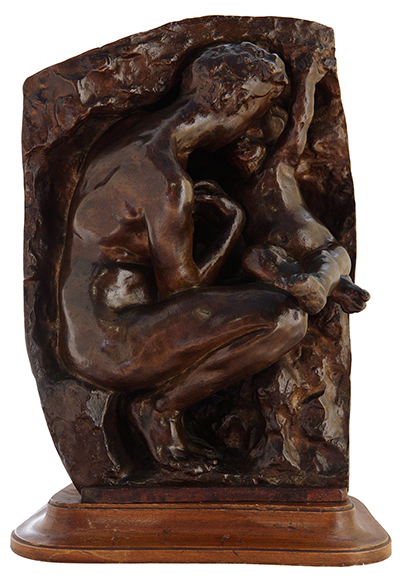Young Mother in a Grotto is a plaster sculpture created by French sculptor Auguste Rodin in 1885. It was first seen at the Salon in Paris later that same year. It is currently housed in the Musee Rodin in Paris, France. Motherhood is highly idealised in our society. It is something that can be traced back to Mary, mother of Jesus. She is the motherhood ideal and artists have channelled her ever since, particularly in the west.
Whether Rodin was delving into this centuries old preoccupation or simply liked the idea of a mother protecting her child is debatable, but many of his earlier works revolve around the mother child concept. The mother is crouching in a grotto, protecting her infant from the elements. Protecting a child is an instinctive thing to do for most adults, but Young Mother in the Grotto also conveys tenderness and love. The mother's face and entire body is drawn inwards toward the child and the child appears to be stretching out to be closer to his mother.
Rodin was very much a product of the times. His sculptures, including Young Mother in a Grotto have a timeless about them and draw a lot on classical ideas. He was no rebel even if some thought he was. Many of his sculptures were criticised as too rough and overly naturalistic, but even while alive, collectors recognised the value and uniqueness of his work, commissioning work.
Rodin was unusual in that he usually made quick sketches in clay from live life models in his studio, later refining them and in the case of Young Mother in the Grotto, casting the final work in plaster. Clay has the benefit of being malleable and reusable. In later years he moved from mother and child to man and women. His females became overtly feminine and his males very masculine. This was in part, a continuation of his early interests in naturalism.
Rodin's reputation expanded. He became the leading French sculpturist of his era and is now considered the forefather of modern sculpture. Auguste Rodin died in 1917 Today, Auguste Rodin is celebrated and highly collectable. An avid collector while alive, he left the French government his studio and thousands of sculptures and drawings. The Musee Rodin which now houses much of his work, is where he lived out the remaining days of his life, the Hotel Biron.




